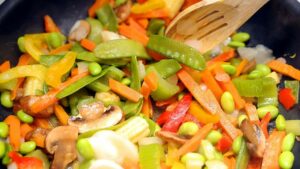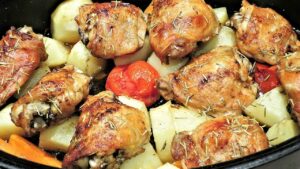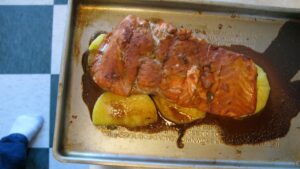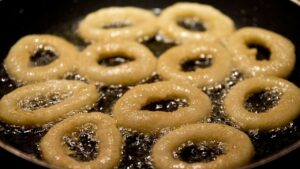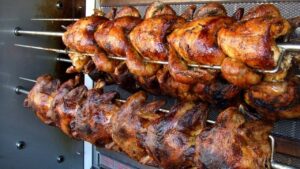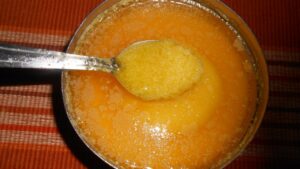What is Searing?
Searing is a cooking technique that involves exposing cooking ingredients to high temperatures, resulting in a crispy and brown exterior. During searing, a small amount of fat or butter is often used to enhance the flavor of the dish.
While searing helps develop texture by creating a brown and crispy surface, it does not necessarily make the food more tender. The caramelized crust that forms on the exterior of the food is a characteristic outcome of searing.
Key Takeaways
- Searing is a cooking technique that is done at 300°F to 500°F.
- Over searing will burn the food and spoil the taste.
- Searing technique is good for cooking fish, meat, and other high protein foods.
- You must know the smoking point of the oil and preheat the pan before searing.
Understanding Searing
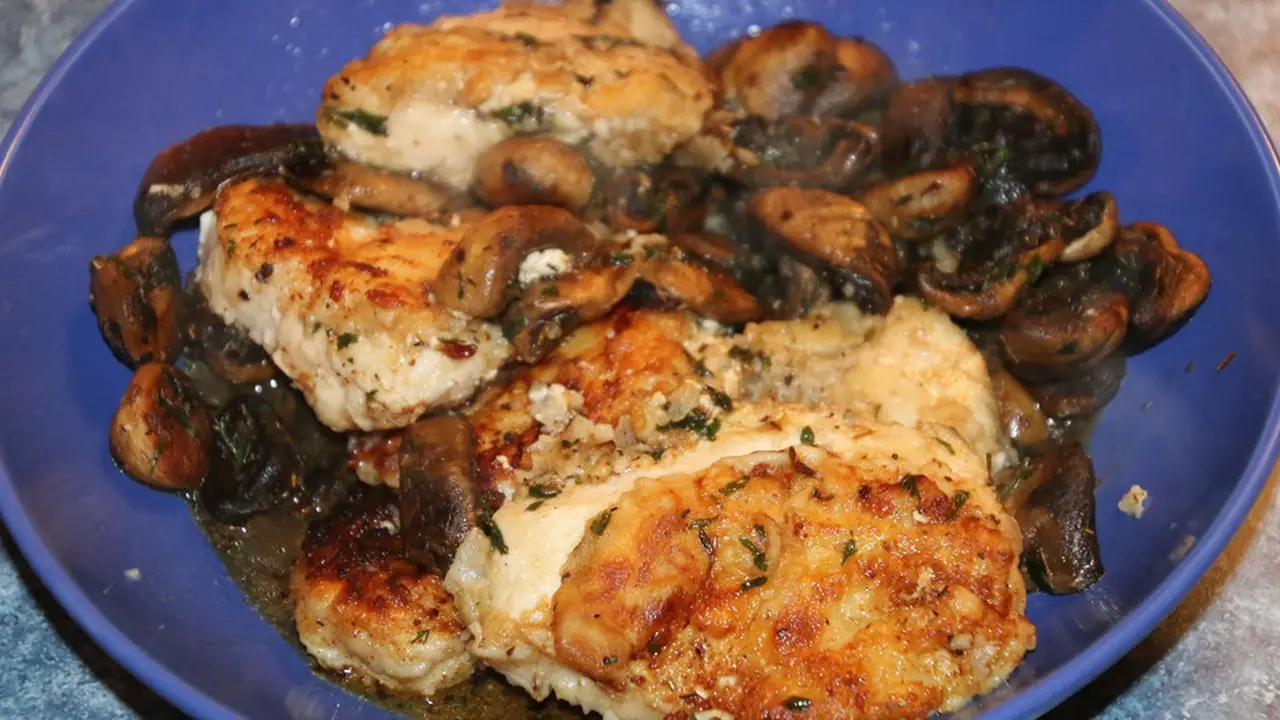
The term “searing” is derived from the Latin word “serāre,” which means “to bar.”
Its origins can be traced back to Middle English, where the words “sēar” and “sēarian” emerged. “Seren,” an Old English word meaning “to dry” or “to wither,” is also associated with searing.
In the context of firearms, searing refers to mechanisms involving the grip, which signifies “to close” or “to lock up.”
Searing, as defined, involves cooking something until it turns brown and helps seal in the juices.
Harold McGee, in his book “On Food and Cooking,” suggests that searing can help retain the juices, as a slice of seared meat tends to be juicier compared to other cooking methods.
However, some chefs dispute the notion that searing completely seals in the juices.
Caramelization, which occurs when sugar is present, contributes to the brown surface and the formation of a roasted upper crust.
To achieve a perfect sear, it is recommended to use a high heat source, akin to a blast furnace, which typically requires temperatures ranging from 300°F to 500°F.
Meat can begin to burn and char within 60 seconds at such high heat, so it is crucial to avoid overcooking.
Timing is key, and the specific duration will depend on factors such as the fat content and type of food being cooked.
For a successful sear, a well-heated surface with a clean cooking surface is essential.
This ensures optimal contact between the food and the cooking surface. The surface can be oiled, and the food should be added once the cooking surface reaches its highest smoking point.
The food should be flipped when it achieves a desirable brown color, but not to the point of becoming blackened.
The color of the seared surface can serve as an indicator of the food’s doneness.
Importance of Searing in Cooking
Searing is a cooking method that holds significant importance in enhancing the flavor and texture of food.
By achieving a delicious and crusty exterior, it adds depth and richness to dishes. Several key reasons make searing a valuable technique:
Minimal attention required: Searing requires less hands-on attention during the cooking process. Once the food is added to the hot surface, such as a pan or grill, it is important to flip it at the right time.
Beyond that, the cooking largely takes care of itself, allowing you to attend to other tasks while the food cooks.
No need for resting: Unlike some cooking methods, seared food does not require extensive resting time before being served.
The natural juices within the food are retained, resulting in a tender and flavorful meal that can be enjoyed immediately.
Pan drips for sauce: The excess marinade or drippings from seared food can be caramelized and used to create a delicious sauce.
Utilizing the pan drippings enhances the overall flavor profile of the dish and allows for a cohesive and complementary sauce to accompany the meal.
Versatile seasoning options: When searing food, you have the freedom to add a variety of seasonings to enhance and tenderize the flavors.
Ingredients such as Korean chili flakes, ginger, butter, soy sauce, and other seasonings can be used creatively, providing endless possibilities for culinary exploration.
Easy and effective: Searing is a straightforward and efficient cooking method that yields excellent results.
By simply applying high heat to the food, such as in a hot pan or grill, and achieving a desirable crust on the outside while maintaining juiciness and tenderness inside, you can easily prepare a flavorful dish.
Superior crust formation: Searing triggers the Maillard Reaction, which leads to the formation of a thick, brown crust on the surface of the food.
This reaction occurs when heat interacts with proteins, resulting in enhanced flavor and visual appeal. The crust acts as a seal, locking in moisture and ensuring a succulent interior.
Precise and even cooking: Searing allows for precise and even cooking of the food. The high heat quickly cooks the exterior, while the lower temperature ensures that the interior is cooked to perfection.
This method provides consistent results without the need for extensive monitoring or adjustments.
Tips of Searing Food
To achieve perfect searing results, there are several techniques and tips to keep in mind.
Searing is particularly suitable for seafood, chicken, steak, and other proteins, as it imparts unmatched flavor, color, and texture to the food.
Select the right pan: Choosing the appropriate pan is crucial for achieving a perfect sear.
Certain ingredients like chicken, salmon, and steaks benefit from a pan that facilitates the formation of a crispy exterior while keeping the interior tender. Consider using a pan that provides optimal heat transfer.
Choose the right fat: Different fats have varying smoking points. Butter, ghee, olive oil, and canola oil all have different smoking points.
When searing, it is recommended to use an oil with a high smoking point, as searing temperatures typically range from 300°F to 500°F.
Bring food to room temperature: If you’re searing meat, it is advisable to let it come to room temperature before cooking.
Removing the meat from the refrigerator at least 30 minutes in advance helps ensure more even cooking and desirable results.
Pat dry the food: Before cooking, patting dry the protein is important to promote even cooking. A dry surface helps create a crustier exterior while maintaining a tender interior.
Use a clean paper towel to pat dry the protein, being cautious to avoid any cross-contamination.
Preheat the pan: Preheating the pan is crucial to searing success. Once the pan has reached the desired temperature, you can add the food.
This step is essential for achieving the right color and crust on the food. Test the pan’s temperature by sprinkling a few drops of water on its surface. If the water quickly evaporates, the pan is ready.
Use cornstarch to prevent sticking: To prevent the food from sticking to the pan, you can lightly dust it with cornstarch. This helps create a crusty layer on the food without compromising the cooking process.
Be patient: Patience is key when searing. Flip the food and check the color development on each side. When the protein no longer sticks to the pan, it’s time to flip it.
Avoid rushing the process to prevent burning the exterior. Even cooking allows the juices to develop, which can be used to make delicious sauces.
Flip the food frequently: When searing slices of meat, it’s recommended to flip them when they reach the desired internal temperature or when they start sticking to one side.
Regular flipping helps prevent overcooking or burning the exterior, ensuring even cooking and flavorful results.
Additionally, flipping the food helps distribute the juices evenly throughout the protein.
Utilize the crust: When pan searing, be sure to incorporate the flavorful crust into the final dish.
The crust contains the concentrated flavors of the entire recipe, adding depth and complexity to the overall taste.
Uses of Searing in Indian Cuisine
Searing is a cooking technique that is widely used in Indian cuisine to enhance flavors, create textures, and develop rich, aromatic dishes.
This technique is particularly popular in various regional cuisines throughout India. Here are some of the primary uses of searing in Indian cooking:
Developing Flavorful Curries: Searing plays a crucial role in the preparation of curries, which are the heart of Indian cuisine.
In many recipes, the process begins by searing spices, such as whole or ground cumin, coriander, mustard seeds, and fenugreek, in hot oil or ghee.
This step helps release the essential oils and intensify the flavors of the spices, resulting in a more robust and aromatic curry base.
Browning Meat and Poultry: Searing is often used to brown meat and poultry before incorporating them into various Indian dishes.
Whether it’s marinated chicken for tandoori, chunks of lamb for biryanis, or pieces of beef for curries, searing the meat helps seal in the juices and create a flavorful crust.
This adds depth and complexity to the final dish, enhancing its taste and texture.
Enhancing Vegetables: Searing is not limited to meats and poultry; it is also employed to elevate the flavors of vegetables in Indian cuisine.
Ingredients like potatoes, cauliflower, paneer (Indian cottage cheese), and mushrooms are often seared before being used in curries, stir-fries, or side dishes.
This technique imparts a delicious caramelized flavor and enhances the overall taste and texture of the vegetables.
Toasting Spices and Nuts: Searing is used to toast whole spices, such as cumin, fennel, mustard, and cardamom, as well as nuts like almonds, cashews, and peanuts.
Dry-roasting these ingredients in a hot pan or skillet intensifies their flavors, brings out their natural oils, and adds a delightful aroma to Indian dishes.
Toasted spices and nuts are then ground or used whole in various recipes, such as spice blends, chutneys, and rice dishes.
Creating Tadka/Tempering: Searing is an essential step in the process of tempering or tadka, a technique used to infuse oil or ghee with spices and aromatics.
Commonly employed in dal (lentil) dishes and vegetable preparations, tadka involves heating oil or ghee until hot and then adding spices like cumin, mustard seeds, dried red chilies, curry leaves, and asafoetida.
The spices are quickly seared, releasing their flavors into the oil or ghee, which is then poured over the prepared dish, enhancing its taste and aroma.
In Indian cuisine, searing is a versatile technique used to elevate the flavors and textures of a wide range of ingredients.
It adds depth, richness, and complexity to dishes, making them more delicious and satisfying.
Whether it’s creating flavorful curries, browning meats, toasting spices, or tempering oils, searing plays a crucial role in the vibrant and diverse culinary traditions of India.
Questions & Answers:
Does Searing Meat Lock in Juices?
The common belief that searing meat helps to "lock in" juices is a popular myth. Searing meat creates a flavorful crust on the surface by browning the proteins and caramelizing the sugars, but it does not actually seal in juices.
How Long to Sear Meat Before Roasting?
The duration for searing meat before roasting can vary depending on the thickness and type of meat, as well as personal preference.
However, as a general guideline, it is recommended to sear the meat for 2-3 minutes on each side.
What is Meant by Pan Seared?
Pan searing is a cooking technique where food, typically meat or fish, is cooked in a hot skillet or frying pan over high heat.
The process involves quickly searing or browning the surface of the food to develop a flavorful crust while keeping the interior tender and juicy.
Conclusion
Finally, searing is a cooking technique that involves exposing ingredients to high temperatures, resulting in a crispy and brown exterior.
It enhances the flavor and texture of food by creating a delicious crust and does not necessarily make the food more tender.
Searing is versatile and widely used in Indian cuisine to develop flavors, brown meat, enhance vegetables, toast spices and nuts, and create aromatic tadka.
While searing does not lock in juices, it adds depth and richness to dishes.
Understanding the key aspects of searing and following proper techniques can help achieve excellent results in cooking.

